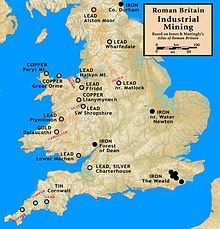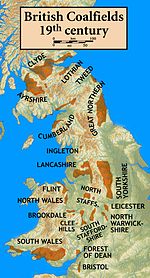- Mining in Wales
-
Mining in Wales provided a significant source of income to the economy of Wales throughout the nineteenth century and early twentieth century.
Wales was famous for its coal mining, in the Rhondda Valley, the South Wales Valleys and throughout the South Wales coalfield and by 1913 Cardiff had become the largest coal exporting port in the world, as coal was transported down by rail. North east Wales also had its own coalfield and Tower Colliery near Hirwaun is regarded by many as the oldest open coal mine and one of the largest in the world.
Contents
History
There had been small-scale mining in Wales in the pre-Roman British Iron Age, but it would be undertaken on an industrial scale under the Romans, who completed their conquest of Wales in AD 78. Substantial quantities of gold, copper, and lead were extracted, along with lesser amounts of zinc and silver. Mining would continue until the process was no longer practical or profitable, at which time the mine would be abandoned.[1] The extensive excavations of the Roman operations at Dolaucothi provide a picture of the high level of Roman technology and the expertise of Roman engineering in the ancient era.
Coal mining
There is evidence of mining in the Blaenavon area going back to the 14th century, and there is evidence of mine workings at Mostyn as far back as 1261,[2] but it is believed to have been practised even as early as Roman times. The coal mining industry burgeoned throughout the Industrial Revolution and into the 19th century, when shafts were sunk to complement the open-cast mining and drift mining already exploiting the ample and obvious coal resources.
During the first half of the nineteenth century mining was often at the centre of working-class discontent in Wales, and a number of uprisings such as the Merthyr Rising in 1831 against employers were a characteristic of the Industrial Revolution in Wales, Dic Penderyn became a martyr to industrial workers. The Chartist movement and the 1839 Newport Rising showed the growing concerns and awareness of the work force of their value to the nation. Although the Factory Acts of the 1830s and resultant Mines Act of 1842 was meant to prevent women and boys under 10 years of age from working underground, it is believed to have been widely ignored. To replace female and child labour the pit pony was more widely introduced. Much later, in the middle of the 20th century, mining was still a hazardous enterprise, resulting in many accidents and long term ill-health with many of Blaenavon's older citizens still suffering from silicosis and other mining related diseases.
Incorporating the existing Coity colliery and Kearsley's pit (sunk in 1860), the Big Pit opened in 1880, so called because it was the first shaft in Wales large enough to allow two tramways. At the height of coal production, there were over 160 drift mines and over 30 shafts working the nine seams in the Blaenavon locality. Big Pit alone employed some 1,300 men digging a quarter of a million tons of coal a year. Large amounts of coal were needed to supply the local ironworks, as it took 3 tons of coal to produce a ton of iron. Blaenavon 'steam' coal was of high quality and it was exported globally. Burning hotly while leaving minimum ash, it was ideal to power the steam engines that drove steamships, Dreadnoughts of the Royal Navy and steam locomotive railways across the world.
However both economics and politics after World War I with its resultant general strike, the 1930s Depression and later Nationalisation and the miners' strike of 1984-1985 took their toll and all the smaller pits were either abandoned or swallowed into Big Pit's encroaching search for new seams. Finally in February 1980 the coal ran out and even Big Pit, then the oldest mine in Wales, had to close.
There are still nine headstocks remaining in Wales, including Big Pit (the metal frame erected in 1921 during the Miners' Strike of that year, to replace a wooden structure).
 Big Pit museum at Blaenavon
Big Pit museum at Blaenavon
Big Pit National Coal Museum & other mining museums in Wales
The Big Pit National Coal Museum is located at Blaenavon, and in 2005 it won the prestigious Gulbenkian Prize for museum of the year. It is one of only two remaining mines where it is possible for visitors to journey to the underground workings some 300 ft (90 m) below using the same cages that transported the miners.
Other museums preserving the memories and heritage of the coal mining industry in Wales are at :
- South Wales Miners' Museum near Cymmer
- Cefn Coed Colliery Museum near Crynant
- Rhondda Heritage Park near Trehafod
Slate mining
Main article: Slate industry in WalesNorth Wales also had a significant slate mining industry.
Gold mining
Main article: Welsh goldWorking mines
Following the miners' strike, the only two deep mines remained working in Wales. Tower Colliery, Hirwaun, had been run by a miner's co-operative since 1994. Due to dwindling coal seams, the colliery was last worked on January 18, 2008 and the official closure of the colliery occurred on January 25.[3] Mining continues at Aberpergwm Colliery, a smaller mine closed by the National Coal Board in 1985 but reopened in 1996. Several other small mines still exist, including the Blaentillery drift mine near to the Big Pit National Coal Museum.
List of mines in Wales
Coal
- Aberpergwm (anthracite coal, drift mine, active in 2011 [4]; operated by Walter Energy; about 230 employees; reserves about 6.8 Mtons, production about 150ktons/yr) [5]
- Bedwas Navigation Colliery
- Bersham (closed 1986)
- Big Pit National Coal Museum
- Blaenant Colliery (closed 1990)
- Cefn Coed Colliery Museum
- Deep Navigation Colliery, Treharris
- Ffos-y-fran Land Reclamation Scheme
- Gresford Colliery (closed 1973)
- Lady Windsor Colliery in Ynysybwl (closed 1988); linked underground to Abercynon Colliery
- Mardy Colliery in Maerdy (closed 1990, site cleared and now occupied by Avon Rubber); linked underground to Tower Colliery
- Mostyn Colliery (closed 1887 after flooding)
- Nantgarw Colliery (amalgamated with Windsor Colliery in 1974, closed 1986); deepest pit in the South Wales Coalfield when sunk in 1915
- Nine Mile Point Colliery at Cwmfelinfach (closed 1964)
- Oakdale Colliery at Ty Mellyn in the Sirhowy Valley (closed 1989; linked to Markham and Celynen North)
- Point of Ayr (closed 1996)
- Universal Colliery at Senghenydd, site of the Senghenydd Colliery Disaster; converted to a ventilation facility for Windsor Colliery and then closed in 1988
- Seven Sisters anthracite; closed 1963
- Tower Colliery (closed 1994 and re-opened after an employees' buy-out by Goitre Tower Anthracite in 1995; closed 2008 after exhaustion of the seam, but with plans to build an open-cast mine in its place)
- Windsor Colliery in Abertridwr, Caerphilly; closed 1986
- Wyllie Colliery in the Sirhowy Valley; closed 1968
Metal ores
- Sygun Copper Mine
- Clogau Gold Mine
- Dolaucothi Gold Mines
- Gwynfynydd gold mine
- Great Orme copper
- Parys Mountain copper mine
- Llywernog Silver Lead Mine
- Minera Leadmines
- Van Leadmine Llanidloes
- Bryntail lead mine
- Cilcain lead mine
- Cwmystwyth Mines
See also
- Coal mining
- The Stars Look Down
- The Citadel
- Idris Davies the coal mining poet from Rhymney
- Mining accident
- Miners' institute
References
- ^ Jones, Barri; Mattingly, David (1990), "The Economy", An Atlas of Roman Britain, Cambridge: Blackwell Publishers (published 2007), pp. 175–195, ISBN 9781842170670
- ^ The History of the Parishes of Whiteford and Holywell; Thomas Pennant, 1796, p.133
- ^ "Coal mine closes with celebration". BBC News. January 25, 2008. http://news.bbc.co.uk/1/hi/wales/7200432.stm. Retrieved 2008-01-25.
- ^ "Three treated after Aberpergwm mine incident". http://www.bbc.co.uk/news/uk-wales-15570702.
- ^ "Aberpergwm's new owner sees bright future in mine". http://www.walesonline.co.uk/business-in-wales/business-news/2010/08/11/aberpergwm-s-new-owner-sees-bright-future-in-mine-91466-27037573/.
External links
- Welsh Coal Mines - all the Welsh pits and their brief histories
- BBC Wales Coal House website
- 42 pages of mining photos compiled by John Cornwell and held on Gathering the Jewels
- Coal Mining in Blaenavon
Categories:
Wikimedia Foundation. 2010.



